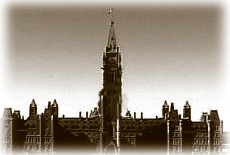The Centre Block,
also known as the Legislative Building, contains the House of Commons,
the Senate, the Chambers, committee rooms and offices of the main officials.
The Parliament Buildings of the Province of Canada were  originally designed in High Victorian Gothic Revival
style in 1859, eight years before Confederation. After the fire of February 3, 1916, the only section remaining of
the original buildings was the Parliamentary Library. John A. Pearson,
of Toronto, and Jean-Omer Marchand, of Montréal, spent four weeks together planning
the new designs. They incorporated the Parliamentary Library and used
as their base the original floor plan of 1859.
originally designed in High Victorian Gothic Revival
style in 1859, eight years before Confederation. After the fire of February 3, 1916, the only section remaining of
the original buildings was the Parliamentary Library. John A. Pearson,
of Toronto, and Jean-Omer Marchand, of Montréal, spent four weeks together planning
the new designs. They incorporated the Parliamentary Library and used
as their base the original floor plan of 1859.
Omer Marchand was trained at L'École des Beaux Arts in Paris, and it was his influence that led the new buildings to be built in a Modern Gothic Revival style. John A. Pearson became the main architect, and Marchand remained on the project as a consultant. Every aspect of the construction of the Centre Block was carefully screened by the Joint Committee on the Reconstruction of the Parliament Buildings headed by Prime Minister Robert L. Borden. The most significant change in the Centre Block was the addition of two additional stories, resulting in 47% more space.